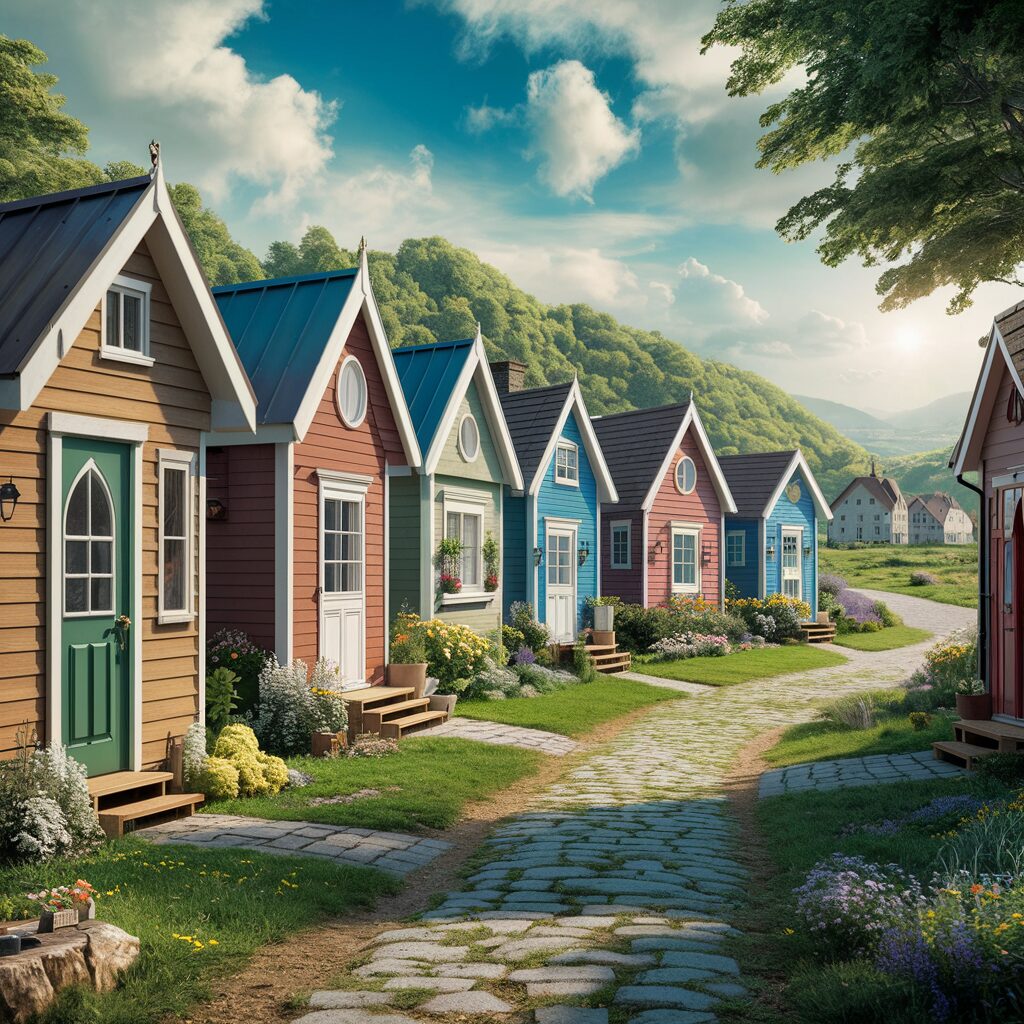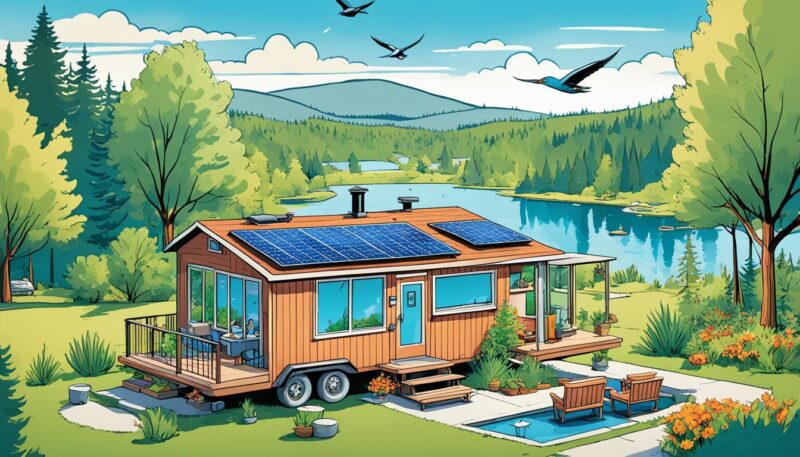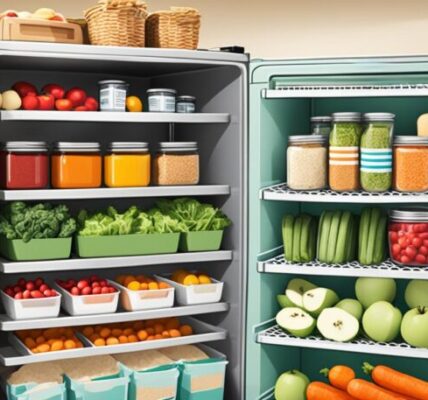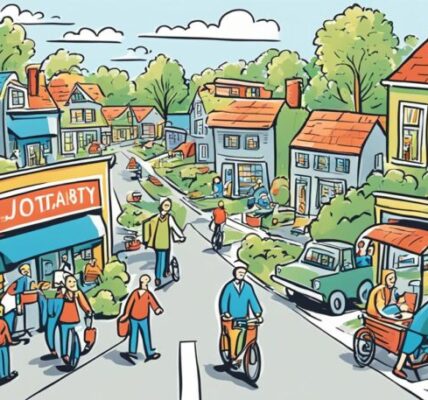Did you know that the average price of a new home in the United States is over $350,000? With such skyrocketing prices, it’s no wonder that many people are seeking affordable housing alternatives. Whether you’re looking to downsize, save money, or embrace a more sustainable lifestyle, there are numerous low-cost living solutions that can meet your needs. From tiny homes and manufactured homes to shipping container dwellings and modular homes, these budget-friendly housing options offer an array of frugal living choices. Let’s explore these cost-effective housing options and discover the economic living alternatives available for those seeking a more affordable way of life.
Key Takeaways:
- Alternative living options provide affordable housing alternatives to traditional homes
- Tiny homes offer simplicity, affordability, and sustainable living
- Shipping container homes transform storage into comfortable, eco-friendly dwellings
- Prefabricated homes provide quick and affordable construction
- Accessory Dwelling Units maximize space and income for homeowners
Tiny Houses: Embracing Simplicity and Affordability

Tiny houses have gained immense popularity as an alternative to traditional homes. These compact dwellings range in size from 100 to 400 square feet, offering a simplistic and minimalistic living experience. The concept behind tiny houses revolves around downsizing and minimizing material possessions, leading to a more sustainable and affordable lifestyle.
One of the key advantages of tiny houses is their minimalistic design. With limited space, every inch is utilized efficiently, resulting in a clutter-free living environment. This design approach promotes a sense of mindfulness and forces individuals to prioritize what truly matters to them, shedding excess and focusing on the essentials.
In addition to their design, tiny houses boast lower maintenance costs compared to traditional homes. With less square footage and fewer amenities to maintain, homeowners can save significantly on utility bills, repairs, and overall upkeep. This lower financial burden makes tiny houses an attractive and affordable housing option for those looking to minimize their expenses and live more sustainably.
Tiny houses offer a sustainable living solution, both in terms of their environmental impact and their ability to support off-grid living. Many tiny homes incorporate eco-friendly features such as solar panels, rainwater harvesting systems, and composting toilets. These sustainable elements not only reduce the ecological footprint of the house but also allow homeowners to live independently from utility grids, promoting self-sufficiency and a decreased reliance on traditional resources.
Despite their small size, tiny houses can provide all the necessary amenities for comfortable living. Well-designed tiny homes often feature efficient layouts that maximize space utilization. They typically include a kitchen, bathroom, sleeping area, and a cozy living space. Clever storage solutions and multipurpose furniture help optimize the available space, ensuring that residents can enjoy a comfortable and functional living environment.
Overall, tiny houses offer an affordable housing option that aligns with the principles of minimalism, sustainability, and off-grid living. Their compact design, lower maintenance costs, and eco-friendly features make them an attractive choice for individuals seeking a more affordable and sustainable way of living.
Shipping Container Homes: Transforming Storage into Living Space
Shipping container homes have gained popularity as a creative and cost-effective alternative to traditional houses. Made from recycled steel shipping containers, these homes offer the perfect combination of sustainability and imaginative design, transforming once-functional storage units into comfortable living spaces.
By repurposing shipping containers, individuals can create unique and eco-friendly dwellings that provide an affordable housing option. With their durable construction and longevity, shipping container homes offer a long-term solution for those seeking comfortable living spaces.

These homes can be customized and combined to form imaginative designs and layouts, allowing for artistic expression and the creation of personalized living environments. Whether it’s a single container home or a multi-container structure, the possibilities for creative design are endless.
Furthermore, shipping container homes are an eco-friendly choice, as they recycle existing materials and reduce the demand for new construction resources. By repurposing shipping containers, individuals can contribute to a more sustainable future while enjoying the benefits of an affordable and stylish living space.
Benefits of Shipping Container Homes:
- Affordable housing option
- Recycled steel construction
- Comfortable living spaces
- Imaginative design possibilities
- Eco-friendly dwellings
| Benefits | Description |
|---|---|
| Affordable housing option | Shipping container homes provide a cost-effective alternative to traditional houses, making homeownership more accessible. |
| Recycled steel construction | By repurposing shipping containers, these homes contribute to sustainable construction practices by reducing the demand for new materials. |
| Comfortable living spaces | Despite their compact size, shipping container homes can be transformed into comfortable and functional living spaces, offering all the amenities of a traditional home. |
| Imaginative design possibilities | With their modular nature, shipping containers can be creatively combined and customized to create unique and imaginative living environments. |
| Eco-friendly dwellings | Choosing a shipping container home contributes to a greener lifestyle by repurposing materials and lowering the environmental impact of construction. |
Prefabricated Homes: Quick and Affordable Construction

Prefabricated or prefab homes offer a streamlined approach to sustainable living, making them a popular choice for those seeking a cost-effective housing option. These homes are designed and made off-site, allowing for minimized construction waste and faster building times. With a focus on efficiency and customization, prefab homes are an excellent solution for individuals looking for quick and affordable housing.
One of the key advantages of prefab homes is their minimized construction waste. Since these homes are built in a factory setting, materials are carefully selected and utilized to avoid unnecessary waste. This efficient approach not only reduces the environmental impact but also helps to keep costs down.
When it comes to construction time, prefab homes outshine traditional building methods. With much of the construction work completed off-site, the on-site assembly can be done in a matter of days or even hours. This streamlined process saves both time and money, making prefab homes an attractive option for those in need of a quick housing solution.
Customization is another benefit of prefab homes. Whether it’s the layout, design, or energy-efficient features, prefab homes can be tailored to meet individual preferences and needs. Companies like Boxabl even offer prefabricated units that can be delivered and assembled on the same day, providing a convenient and cost-effective solution for those looking for their dream home.
Overall, prefab homes offer a sustainable and affordable housing option. With their minimized construction waste, streamlined approach, and customization possibilities, these homes provide a practical and efficient alternative to traditional construction methods.
Accessory Dwelling Units: Maximizing Space and Income

Accessory Dwelling Units (ADUs) are additional living units that can be constructed on existing properties. These units allow homeowners to maximize their space and generate rental income. By building an ADU, individuals can avoid the high costs of purchasing or renting a separate property, ultimately saving money in the long run.
ADUs provide a practical and affordable way to create additional housing options while offering homeowners potential financial benefits. They can range from tiny houses to shipping container homes, depending on the desired design and functionality.
Benefits of Accessory Dwelling Units:
- Maximize Space: ADUs provide homeowners with the opportunity to make the most of their existing property by adding additional living space. This is especially beneficial for families with growing children, elderly parents, or those looking to have a separate home office or creative space.
- Generate Rental Income: Renting out the ADU can provide homeowners with a valuable source of additional income. With the rising demand for affordable housing options, ADUs offer a rental potential that can help offset mortgage payments and contribute to financial stability.
- Affordable Housing Option: Building an ADU is often more cost-effective than purchasing or renting a separate property. Homeowners can save on upfront costs while still enjoying the benefits of having an additional living unit on their property.
Overall, Accessory Dwelling Units offer homeowners the opportunity to maximize their space, generate rental income, and provide an affordable housing option. Whether it’s a cozy tiny house or a creative shipping container home, ADUs present a practical and financially beneficial solution for those looking to make the most of their property.
Manufactured Homes: Affordable and Convenient Housing Solutions
Manufactured homes, also known as mobile homes, offer affordable housing options that conform to HUD codes. These homes are built off-site and transported to their final location, providing a cost-effective and convenient solution for those seeking affordable housing options. Manufactured homes have evolved significantly in terms of quality and design, offering homeowners the opportunity to own a comfortable and affordable living space.
These homes adhere to safety regulations and are designed to meet the standards set by the Housing and Urban Development (HUD). This ensures that manufactured homes provide a reliable and secure housing option for individuals and families.
One of the key advantages of manufactured homes is their affordability. Compared to traditional houses, manufactured homes offer a more cost-effective way of achieving homeownership without compromising on quality.
Convenience is another significant benefit of manufactured homes. Since these homes are constructed off-site, the construction process is typically faster and more streamlined. This allows homeowners to move into their new residence sooner, minimizing the time and expenses associated with traditional construction methods.
Moreover, manufactured homes offer a wide range of floor plans and customization options, allowing homeowners to tailor their living space to their specific needs and preferences. This flexibility ensures that individuals can create a comfortable and personalized environment that suits their lifestyle.
Overall, manufactured homes provide an excellent alternative to traditional houses, offering affordability, convenience, and quality. With their adherence to safety regulations and affordability, they are a sensible choice for those seeking cost-effective and convenient housing solutions.
You can also read: UK Bonus Taxation Explained
Conclusion
With rising housing costs, more and more people are turning to affordable alternatives to traditional homes. From tiny houses and shipping container homes to prefab and manufactured homes, there are numerous cost-effective housing options available. These alternatives not only provide an affordable solution but also offer sustainability and customization.
By thinking outside the box and considering these alternative housing options, individuals can achieve homeownership and financial stability without breaking the bank. Whether it’s embracing simplicity and minimalistic living in a tiny house, transforming shipping containers into comfortable living spaces, or opting for quick and affordable prefab homes, there are budget-friendly housing solutions to cater to everyone’s needs.
These affordable alternatives to traditional homes not only help individuals save money but also contribute to a more eco-friendly and sustainable lifestyle. With their innovative designs and customizable features, they offer an opportunity to live in a space that reflects personal preferences and values.
FAQ
What is a tiny house?
A tiny house is a small home ranging in size from 100 to 400 square feet, designed to prioritize simplicity and minimize material possessions. Tiny homes offer an affordable and sustainable housing option with their minimalist design and lower maintenance costs.
Can tiny houses provide all necessary amenities?
Yes, despite their small size, tiny homes can provide all the necessary amenities, including kitchens, bathrooms, and comfortable living areas. Many tiny homes also incorporate eco-friendly features such as solar panels and composting toilets, allowing for off-grid living.
What are shipping container homes?
Shipping container homes are houses made from recycled steel shipping containers. With a bit of imagination and creativity, these containers can be transformed into comfortable living spaces. Shipping container homes offer a modern and eco-friendly dwelling option that is both stylish and sustainable.
How are shipping container homes constructed?
Shipping container homes are made by combining multiple containers to create unique designs and layouts. These containers provide a durable and long-lasting housing solution that can be customized according to the desired design and functionality.
What are prefab homes?
Prefabricated (prefab) homes are designed and made off-site, reducing building time and minimizing construction waste. They are quickly assembled on-site, offering a cost-effective housing option that allows for customization and energy efficiency.
How quickly can prefab homes be assembled?
Prefab homes can be assembled quickly, as companies like Boxabl offer units that can be delivered and put together on the same day. This makes prefab homes a convenient and affordable choice for those seeking a quick housing solution.
What are Accessory Dwelling Units (ADUs)?
Accessory Dwelling Units (ADUs) are additional living units that can be constructed on existing properties. They allow homeowners to maximize their space and generate rental income. ADUs range from tiny houses to shipping container homes, depending on the desired design and functionality.
What are manufactured homes?
Manufactured homes, also known as mobile homes, are affordable housing options that conform to the standards set by the Housing and Urban Development (HUD). These homes are built off-site and transported to their location, providing cost-effective and convenient housing solutions.
How do manufactured homes compare to traditional houses?
Manufactured homes have come a long way in terms of quality and design, offering homeowners the opportunity to own a comfortable and affordable living space. With their adherence to safety regulations and affordability, manufactured homes provide an excellent alternative to traditional houses.
Why should I consider alternative living options?
Exploring alternative living options is becoming increasingly popular due to rising housing costs. These alternatives offer affordability, sustainability, and customization, making them attractive choices for individuals seeking affordable living solutions that are budget-friendly and cost-effective.




